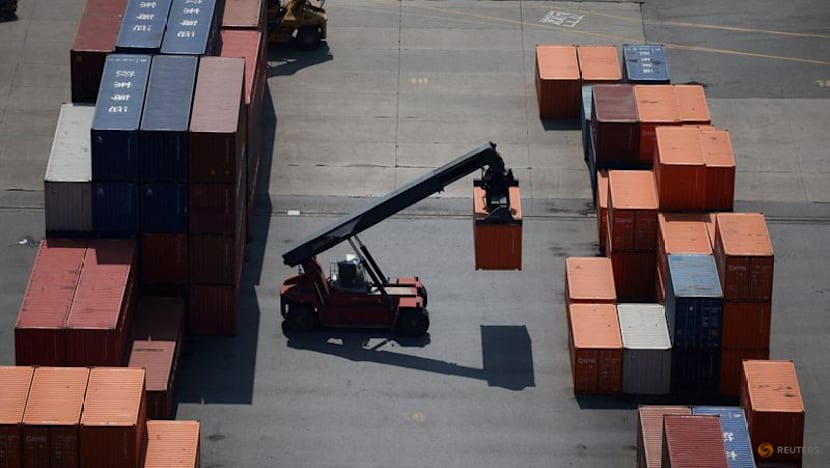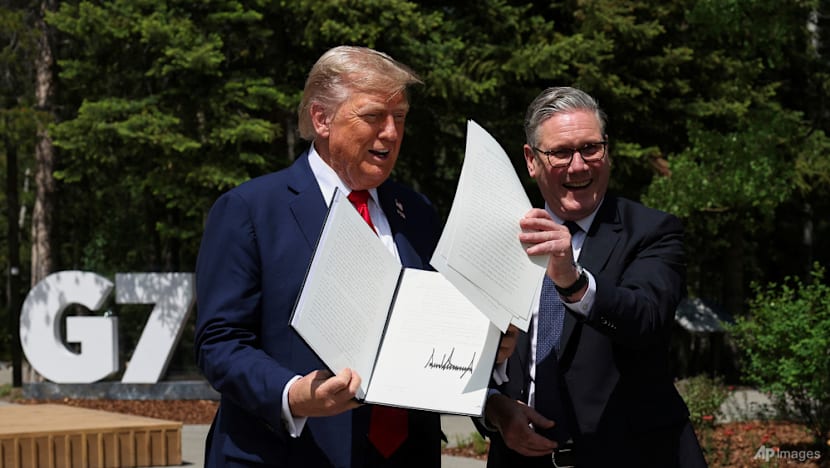Commentary: Several US trade ‘deals’ later, there are still more questions than answers
For ASEAN countries, the immediate question is not whether United States President Donald Trump’s tariffs are legal but how to get greater clarity about trade agreements, says SMU law professor Locknie Hsu.

File photo. Shipping containers are seen at Pyeongtaek port in South Korea, Apr 15, 2025. (Photo: Reuters/Kim Hong-Ji)

This audio is generated by an AI tool.
SINGAPORE: A US federal court ruled in August that President Donald Trump did not have the legal authority to impose tariffs under a US law on emergency economic powers. His administration’s appeal is now headed to the US Supreme Court.
For America’s trade partners, however, the more urgent question has not been whether these particular tariffs are lawful or not under US law. Nor is it about the validity of the recent US tariff actions under World Trade Organization (WTO) rules or whether the WTO is still relevant.
For the past three decades or so, the global trading community had been largely functioning under the multilateral trade system. As flawed as many global institutions may be, the WTO has provided a common, multilateral legal structure within which economies negotiated, disputed and advanced trade issues.
The US’ declaration of “Liberation Day” tariffs on Apr 2 has, however, seemingly ushered in a new paradigm of US-driven trade deals – or what I would call “US-laterals” (as opposed to multilateral or plurilateral agreements which are common in international trade) - both in form and substance.
The broader issue for trade partners is therefore how to navigate the new reality which is emerging from both the tariff announcements and the pragmatic responses in seeking “deals” with the US.
NEGOTIATIONS MORE THAN RETALIATION
Pragmatism, indeed, has led most trading partners down the path of negotiation, rather than retaliation.
Some countries such as Canada and China imposed their own tariffs, though many have been removed as talks with the US progressed. The European Union, too, prepared their own tariffs while juggling negotiations, but suspended their implementation following the EU-US deal.
The Association of Southeast Asian Nations (ASEAN) has categorically embraced a non-retaliation stance, which is clearly articulated in a Joint Statement issued very swiftly on Apr 10. Most of its ten members have successfully negotiated some level of reduced tariff rates.
In agreements with at least three ASEAN countries – Vietnam, Indonesia and the Philippines – the US negotiated significant market access gains for its products, addressed non-tariff barriers, and in some cases, also opened a window for negotiating the meaning of “transshipped” exports from these economies into the US. The US has also obtained significant promises to purchase US products (such as aircraft, renewable energy and agricultural goods).
STILL MORE QUESTIONS THAN ANSWERS
A challenge in understanding the new paradigm is the fact that there appear to be no signed legal agreements yet. The agreement between the United Kingdom and the US, reportedly the first to be “signed”, is not yet a legally binding agreement like a Free Trade Agreement (FTA)
This leads one to query whether the “deals” will eventually culminate in a legally binding treaty, or take some other softer form, comprising key points of agreement which can be flexibly varied from time to time.
So far, the agreements have been referred to as framework agreements, which at least point to further negotiations and more matters to be fleshed out and agreed upon later.
Another pertinent question is what US Treasury Secretary Scott Bessent meant when he referred to the reciprocal tariffs would be a “melting ice cube” as trade imbalances improve. While it suggests tariffs could be lowered, it is unclear what milestones must be achieved (such as when the US achieves a trade surplus with a trade partner, perhaps) or whether there will ever be a full phase-out of the tariffs.

Also, apart from the risk of fresh tariff threats – possibly targeting specific sectors, or countries with digital taxes which the US said discriminates against US tech – there are still more questions than answers at the moment.
For instance, what do “transshipped” goods cover and what if there is disagreement as to whether certain cargo falls within “transshipment” or not? The negotiation of rules of origin by the US with its ASEAN partners is probably in progress but the sooner there is clarity, the better it is for ASEAN and US businesses.
Will the tariffs be varied upon the occurrence of some alleged violation of the agreement? A negotiated, sustained duration for which the tariffs are “locked in”, for example, could provide greater certainty.
What kind of dispute resolution mechanism can be included to efficiently deal with any dispute which may arise regarding the agreement? This question also applies to purchase commitments that were announced with the “deals”.
Will such purchase commitments involve government procurement processes, private entities or public-private contractual arrangements? How would common contract protection tools apply and would non-completion of contracts attract any tariff action?
Will there be any regular joint review exercise so that tariffs can be on a phase-out trajectory, and if so, under what circumstances could it take place?
And importantly, how similar will terms and features across the agreements made by the US with ASEAN countries be to those made with other trade partners? What do members need to consider for such “US-lateral” agreements?
ASEAN REMAINS COMMITTED TO MULTILATERAL TRADING SYSTEM
For those who continue to support the WTO’s multilateral rules system, a further concern would be whether such agreements with the US would satisfy the WTO’s exception to the Most-Favoured Nation (MFN) rule.
This rule requires that trade advantages be extended to all WTO members in compliance with non-discrimination obligations. The exception, allows, on the other hand, trade partners to negotiate preferential trade agreements between themselves if substantially all trade barriers between them are eliminated in these agreements.
The unusual birth pangs which gave rise to the agreements with the US need not necessarily render them inconsistent with WTO rules, to be treated as “illegitimate children” outside of ‘WTO-lock’. That the “deals” may not look like more traditional FTAs, too, need not be an obstacle.
As ASEAN firmly maintains its support for the multilateral trading system, its member states will need to assess if their agreements with the US are compliant with WTO rules. ASEAN is also poised to welcome its 11th member, Timor Leste, in October, and the agreements reached by other members will be instructive.
ASEAN may not have chosen to negotiate as a bloc with the US for a number of reasons, but it can still deepen its internal economic integration and further improve its regulatory and economic environment. In this way, ASEAN can present itself as a “phenomenal” (to use Mr Trump’s term) trade and investment hub not just to the US, but also to the rest of the world, while seeking to remain in compliance with multilateral and regional agreements of which it is part.
Locknie Hsu is a Professor of Law at the Yong Pung How School of Law, Singapore Management University.


















